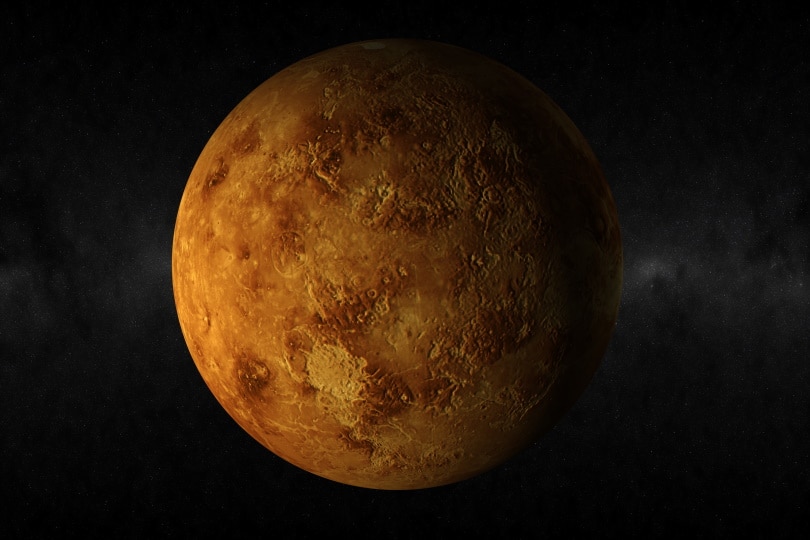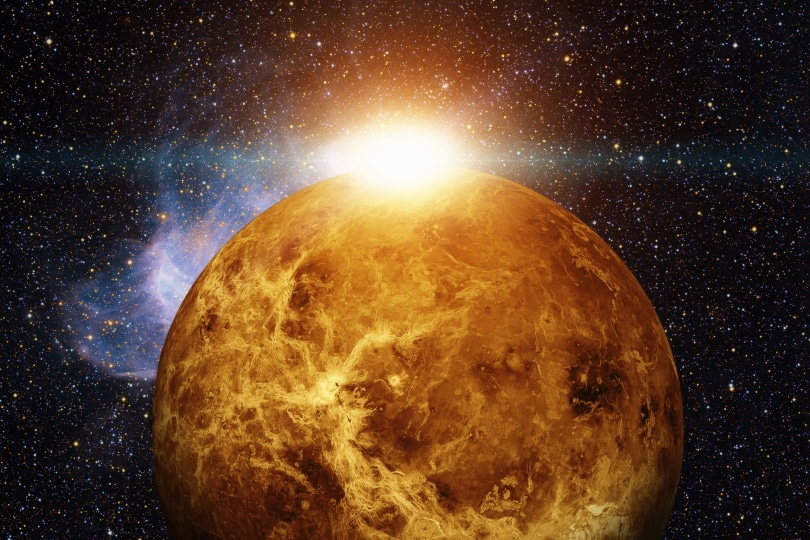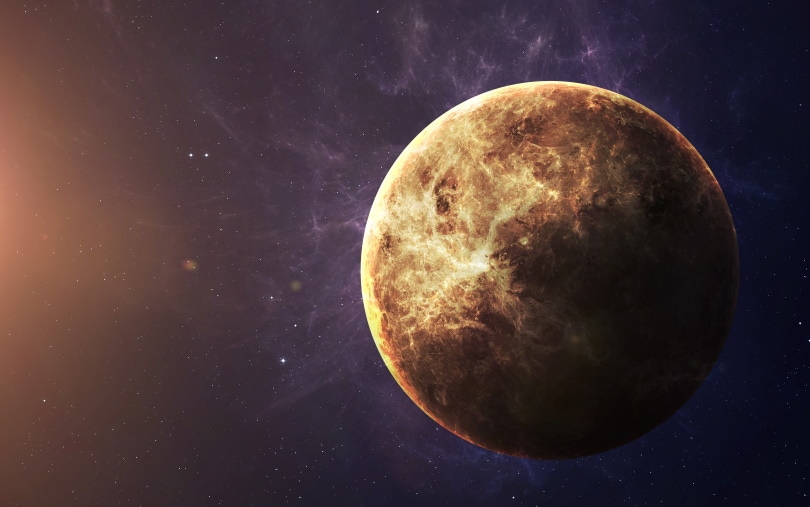11 Interesting Facts About Venus You Never Knew (2024 Updates)
Last Updated on

When you’re looking up at the night sky, you’re bound to see a few different objects going by. One object that you’ve likely seen — and perhaps not realized it — is Venus. It’s the second planet from the Sun, it’s the brightest planet in the sky, and it’s also the most Earth-like.
Those are just a few interesting facts about Venus, and we highlight a few more of them for you here!

Top 11 Facts About Venus
Venus is one of the most interesting planets in the solar system. But don’t just take our word for it! Check out these 11 facts about Venus that highlight just how interesting the second planet from the Sun is.
1. A Day on Venus Is Longer Than a Year
Venus has a slow rotation. In fact, it takes 243 Earth days for Venus to complete just one rotation. Venus is 405 miles smaller than Earth, so it’s a good timetable to use to highlight just how slow Venus rotates.
But Venus orbits the Sun in just 225 Earth days, meaning that Venus goes through more years than days!

2. Venus Is Hotter Than Mercury
Venus might be the second planet from the Sun, but it’s the hottest planet in the solar system. The average temperature of Venus is 462 degrees Celsius, while the average temperature on Mercury is only 167 degrees Celsius.
It all has to do with the vast number of atmospheric gases that capture and trap heat on Venus. It’s why Venus has almost no temperature variation from the daytime to nighttime sides of the planet, while Mercury goes from 430 degrees Celsius during the day to -290 degrees Celsius at night!
3. Venus Spins Backward
In our solar system, every planet except two spins counterclockwise. Uranus spins on its side, and Venus spins in the complete opposite direction by spinning clockwise.
Nobody knows why this is the case, but it’s the only planet in the solar system where you could watch the Sun rise in the west!
4. Venus Was the First Planet Explored by a Spacecraft
Venus has been a bit of a magnet for space travel. In 1962, the Mariner 2 flew past the planet and scanned the atmosphere, marking the first time that a spacecraft explored another world.
The Venera 7 was also the first spacecraft to land on another planet, which was Venus. The extreme heat meant that it didn’t survive long, but simply making it there was an impressive feat!

5. Venus Averages 67 Million Miles From the Sun
While Venus is closer to the Sun than Earth, it’s still more than a few million miles away. At 67 million miles from the Sun, Venus does a great job of showing us just how vast space really is.
6. Venus Has a Solid Surface
Venus does have a solid surface, which is impressive because that surface is so hot that it can melt lead.
The surface also has volcanoes, rifts, and even mountains, making it quite Earth-like despite the scorching heat.
7. Scientists Don’t Know Why the Surface of Venus Is So Young
Young is a relative term, and when you consider that scientists have found rocks over 4 billion years old on Earth, the 150-million-year-old surface of Venus means that it’s practically in its infancy.
Scientists don’t know why the surface of Venus is so young, but it does make a fun puzzle for future scientists to try to figure out!

8. Venus Might Host Life
The second planet to the Sun that’s hot enough to melt lead might not seem like the ideal place to look for life, but many scientists think that’s just where bacterial life might reside.
While the surface might be scorching hot, between 31 and 37 miles above the surface, the atmospheric pressure and temperatures are much like those of Earth.
9. Venus Is the Second Brightest Object in the Night Sky
When the Sun goes down, there are quite a few bright objects in the sky. While you can’t always see Venus at night, when you can, it’s the second brightest object in the sky, right behind the moon.
10. Venus Is the Planet Most Like Earth
While Mars is often the planet that people most associate with being like the Earth, the truth is that Venus is a better match. Venus and Earth have almost identical structures, and their only differences are how close they are to the Sun and the thickness of their respective atmospheres.
So, if you were looking for Earth’s twin in the solar system, it’s Venus, not Mars.

11. The Atmosphere Spins Faster Than the Planet
While Venus has a slow rotation, the speed of its thick atmosphere is anything but slow. It completely circles the planet in just 4 days. We don’t know for sure why it rotates so fast, but it’s one reason that the entire surface of the planet stays so hot and doesn’t cool down much even when it’s facing away from the Sun.

Conclusion
Humans have looked up at the sky and seen Venus for thousands of years, even if we didn’t always know what it was. While it captured the attention of ancient humans, the more that we learn about it now, the more it continues to fascinate.
There are plenty of questions left to answer about Venus, so keep your eyes to the sky — you never know what else you might notice and discover!
Featured Image Credit: TheSpaceway, Pixabay
Table of Contents
- Top 11 Facts About Venus
- 1. A Day on Venus Is Longer Than a Year
- 2. Venus Is Hotter Than Mercury
- 3. Venus Spins Backward
- 4. Venus Was the First Planet Explored by a Spacecraft
- 5. Venus Averages 67 Million Miles From the Sun
- 6. Venus Has a Solid Surface
- 7. Scientists Don’t Know Why the Surface of Venus Is So Young
- 8. Venus Might Host Life
- 9. Venus Is the Second Brightest Object in the Night Sky
- 10. Venus Is the Planet Most Like Earth
- 11. The Atmosphere Spins Faster Than the Planet
- Conclusion
About the Author Robert Sparks
Robert’s obsession with all things optical started early in life, when his optician father would bring home prototypes for Robert to play with. Nowadays, Robert is dedicated to helping others find the right optics for their needs. His hobbies include astronomy, astrophysics, and model building. Originally from Newark, NJ, he resides in Santa Fe, New Mexico, where the nighttime skies are filled with glittering stars.
Related Articles:
15 Crucial Facts About Ultraviolet Rays & the Sun
What Constellation Is Spica In? The Interesting Answer!
10 Interesting Leo Constellation Facts, Myths, and FAQs
15 Interesting Pegasus Constellation Facts, Myths, and FAQs
6 Interesting Sagittarius Constellation Facts, Myths, and FAQs in 2024!
What Are Constellations? Where Did They Come From?
8 Interesting Libra Constellation Facts, Myths, and FAQs
What Is Infrared Radiation? Science-Based Facts & FAQ
